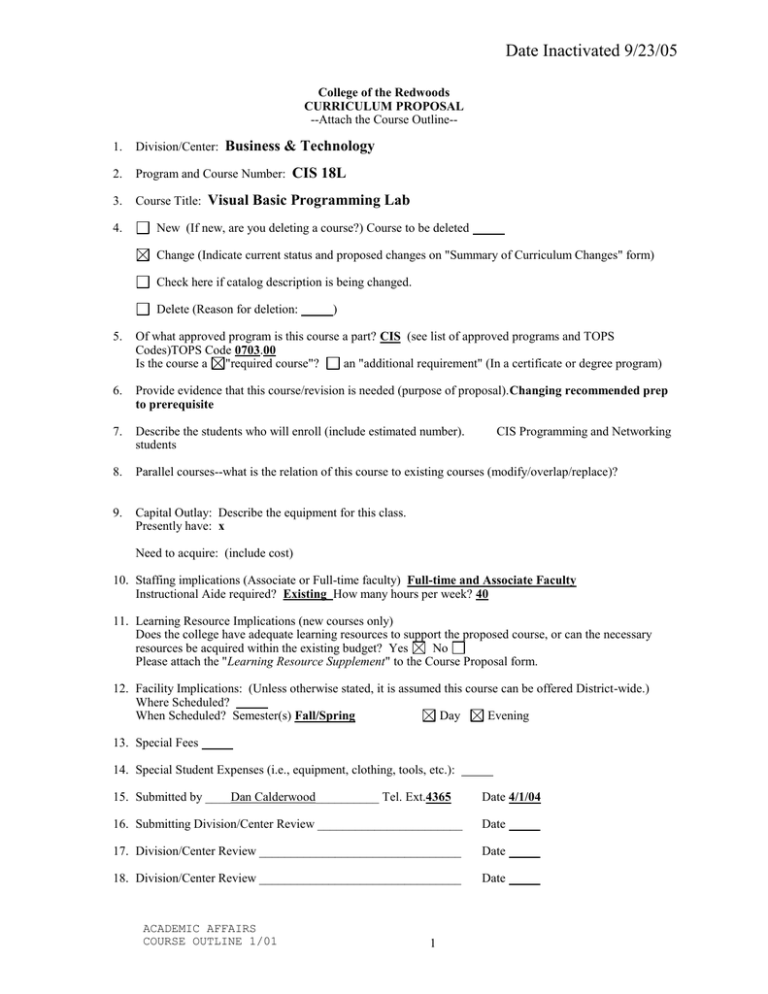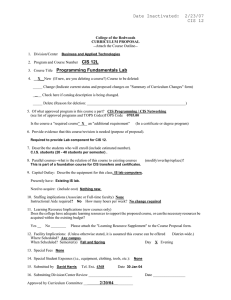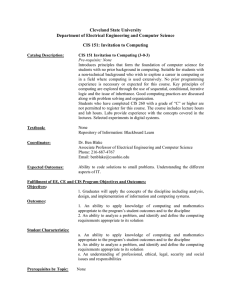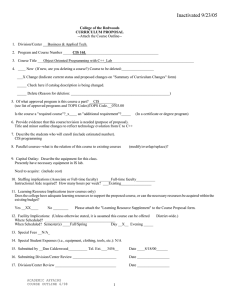Date Inactivated 9/23/05 Business & Technology CIS 18L Visual Basic Programming Lab
advertisement

Date Inactivated 9/23/05 College of the Redwoods CURRICULUM PROPOSAL --Attach the Course Outline-- Business & Technology 1. Division/Center: 2. Program and Course Number: 3. Course Title: 4. CIS 18L Visual Basic Programming Lab New (If new, are you deleting a course?) Course to be deleted Change (Indicate current status and proposed changes on "Summary of Curriculum Changes" form) Check here if catalog description is being changed. Delete (Reason for deletion: ) 5. Of what approved program is this course a part? CIS (see list of approved programs and TOPS Codes)TOPS Code 0703.00 Is the course a "required course"? an "additional requirement" (In a certificate or degree program) 6. Provide evidence that this course/revision is needed (purpose of proposal).Changing recommended prep to prerequisite 7. Describe the students who will enroll (include estimated number). students 8. Parallel courses--what is the relation of this course to existing courses (modify/overlap/replace)? 9. Capital Outlay: Describe the equipment for this class. Presently have: x CIS Programming and Networking Need to acquire: (include cost) 10. Staffing implications (Associate or Full-time faculty) Full-time and Associate Faculty Instructional Aide required? Existing How many hours per week? 40 11. Learning Resource Implications (new courses only) Does the college have adequate learning resources to support the proposed course, or can the necessary resources be acquired within the existing budget? Yes No Please attach the "Learning Resource Supplement" to the Course Proposal form. 12. Facility Implications: (Unless otherwise stated, it is assumed this course can be offered District-wide.) Where Scheduled? When Scheduled? Semester(s) Fall/Spring Day Evening 13. Special Fees 14. Special Student Expenses (i.e., equipment, clothing, tools, etc.): 15. Submitted by ____Dan Calderwood__________ Tel. Ext.4365 Date 4/1/04 16. Submitting Division/Center Review _______________________ Date 17. Division/Center Review ________________________________ Date 18. Division/Center Review ________________________________ Date ACADEMIC AFFAIRS COURSE OUTLINE 1/01 1 Approved by Curriculum Committee __ 5/14/04 SUMMARY OF CURRICULUM CHANGES FEATURES OLD NEW None CIS 12L CIS 11, CIS 12 CIS 11 Grading Standard Prerequisites Corequisites Recommended Preparation Repeatability Maximum Enrollments Repeatability Maximum Units Maximum Class Size TLUs Lectures Hours Lab Hours Method of Instruction Units Other If any of the listed features have been modified in the new proposal, indicate the "old" (current) information and proposed changes. ACADEMIC AFFAIRS COURSE OUTLINE 1/01 2 College of the Redwoods COURSE OUTLINE DATE 4/1/04 PROGRAM AND COURSE NUMBER: CIS 18L FORMER NUMBER (If previously offered) COURSE TITLE: Visual Basic Programming Lab I. CATALOG AND OUTLINE 1. CATALOG DESCRIPTION: An activity course which enables students to become proficient in implementing object-oriented programming solutions in Visual Basic. NOTE: 2. COURSE OUTLINE: Topic Visual Basic Programming Environment Data Definitions Processing Logic GUI Design OLE Database Interfacing Windows Applications % of Classroom Hours Spent on Each 5 10 20 20 20 10 15 II. PREREQUISITES Prerequisite? No Yes Corequisite? No Yes Recommended Preparation? No Yes CIS 12L (course) CIS 18 (course) CIS 11 Rationale for Prerequisite, Corequisite, Recommended Preparation CIS 12L provides fundamentals in problem solving that are necessary for students to succeed in CIS 18L. CIS 11 focuses on computer design and acrchitecture principles. These priciples are helpful for students programming in Visual Basic. The curricula of the lecture and lab portions are interwoven. Students require the continual reinforcement within the lab section of knowledge gained in the lecture section. The lecture and lab are separate courses only because of scheduling necessities ACADEMIC AFFAIRS COURSE OUTLINE 1/01 3 PROGRAM AND COURSE NUMBER CIS 18L III. OUTCOMES AND ASSESSMENTS 1. COURSE OUTCOMES/OBJECTIVES: List the primary instructional objectives of the class. Formulate some of them in terms of specific measurable student accomplishments, e.g., specific knowledge and/or skills to be attained as a result of completing this course. For degree-applicable courses, include objectives in the area of "critical thinking." Upon successful completion of this course, the students will be able to: Use proficiently, an integrated programming environment to write, test, and debug Visual Basic code. Apply problem-solving tools and skills to write software algorithms. Create executable code using Visual Basic. Create graphical user interfaces. Create Windows applications using Visual Basic. Create a database interface using Visual Basic. 2. COLLEGE LEVEL CRITICAL THINKING TASKS/ASSIGNMENTS: Degree applicable courses must include critical thinking tasks/assignments. This section need not be completed for non-credit courses. Describe how the course requires students to independently analyze, synthesize, explain, assess, anticipate and/or define problems, formulate and assess solutions, apply principles to new situations, etc. Students will analyze a problem, formulate a solution and code the solution using Visual Basic and an integrated programming environment. Once students have written the source code for their projects, they will then thoroughly test their projects for accuracy. 3. ASSESSMENT Degree applicable courses must have a minimum of one response in category A, B, or C. If category A is not checked, the department must explain why substantial writing assignments are an inappropriate basis for at least part of the grade. A. This course requires a minimum of two substantial (500 words each) written assignments which demonstrate standard English usage (grammar, punctuation, and vocabulary) and proper paragraph and essay development. In grading these assignments, instructors shall use, whenever possible, the English Department’s rubric for grading the ENGL 150 exit essay. Substantial writing assignments, including: essay exam(s) term or other paper(s) laboratory report(s) written homework reading report(s) other (specify) If the course is degree applicable, substantial writing assignments in this course are inappropriate because: The course is primarily computational in nature. The course primarily involves skill demonstrations or problem solving. Other rationale (explain) B. Computational or Non-computational problem-solving demonstrations, including: exam(s) quizzes homework problems laboratory report(s) field work other (specify) C. Skill demonstrations, including: class performance(s) field work performance exam(s) other (specify) Assignments that require the student to create working code D. Objective examinations, including: multiple choice true/false matching items completion other (specify) code evaluation and creation E. Other (specify) NOTE: A course grade may not be based solely on attendance. ACADEMIC AFFAIRS COURSE OUTLINE 1/01 4 PROGRAM AND COURSE NUMBER CIS 18L IV. TEXTS AND MATERIALS APPROPRIATE TEXTS AND MATERIALS: (Indicate textbooks that may be required or recommended, including alternate texts that may be used.) Text(s) Title: Programming Business Applications with Visual Basic 6.0 Required Edition: 3rd Alternate Author: William H. Burrows, University of Washington Recommended Publisher: Irwin, McGraw Hill Date Published: 2002 (Additional required, alternate, or recommended texts should be listed on a separate sheet and attached.) For degree applicable courses the adopted texts have been certified to be college-level: Yes. Basis for determination: is used by two or more four-year colleges or universities (certified by the Division Dean or Center Dean) OR has been certified by the LAC as being of college level using a Readability Index Scale. No Request for Exception Attached. REQUIRED READING, WRITING, AND OTHER OUTSIDE OF CLASS ASSIGNMENTS: Over a 16-week presentation of the course, 3 hours per week are required for each unit of credit. ALL Degree Applicable Credit classes must treat subject matter with a scope and intensity, which require the student to study outside of class. Two hours of independent work done out of class are required for each hour of lecture. Lab and activity classes must also require some outside of class work. Outside of the regular class time the students in this class do the following: Study Answer questions Skill practice Required reading Problem solving activity or exercise Written work (essays/compositions/report/analysis/research) Journal (reaction and evaluation of class, done on a continuing basis throughout the semester) Observation of or participation in an activity related to course content (e.g., play, museum, concert, debate, meeting, etc.) Other (specify) ACADEMIC AFFAIRS COURSE OUTLINE 1/01 5 PROGRAM AND COURSE NUMBER CIS 18L V. TECHNICAL INFORMATION 1. Contact Hours Per Week: (Indicate "TOTAL" hours if less than semester length) Lecture: Weekly TOTAL Lab: 3 Weekly 54 TOTAL No. of Weeks S (S = semester length) (Use Request for Exception sheet to justify more-thanminimum required hours.) 5. Recommended Maximum Class Size 40 Units 1.0 or Variable Unit Range 7. Grading Standard Letter Grade Only CR/NC Only Grade-CR/NC Option Grade-CR/NC Option Criteria: Introductory 1st course in sequence Exploratory 6. Transferability CSU UC List two UC/CSU campuses with similar courses (include course #s) CSULB/IS 340; CSUC/CSCI 54 Articulation with UC requested 2. TLUs 3.0 3. Does course fulfill a General Education requirement? For existing courses only; for new courses, use GE Application Form) Yes No 8. Is course repeatable Yes No If so, repeatable to a maximum of: Total Enrollments Total Units (Use Request for Exception sheet to justify repeatability.) If yes, in what G.E. area? AA/AS Area CSU/GE Area IGETC Area 9. SAM Classification C Course Classification I 4. Method of Instruction: Lecture Lab Lecture/Lab Independent Study ACADEMIC AFFAIRS COURSE OUTLINE 1/01 6



